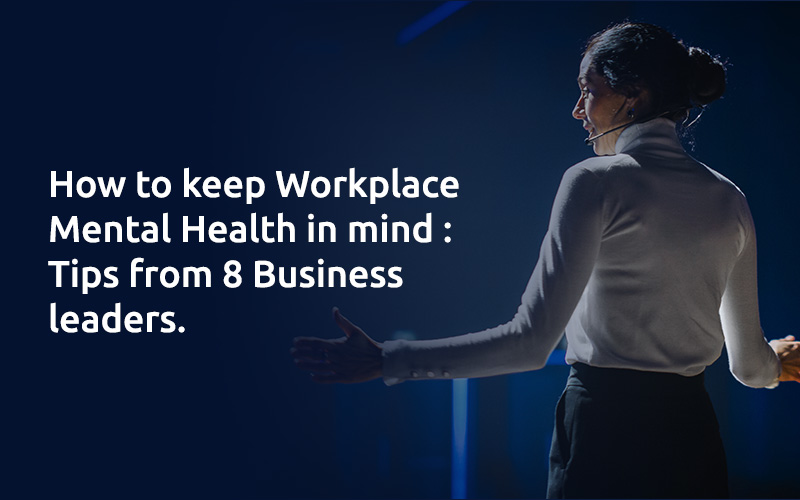
How to keep Workplace Mental Health in mind: Tips from 8 Business leaders.
During this time of major upheaval and uncertainty in our lives, business leaders have had a lot of things to deal with. Nearly seven in 10 employees say the COVID-19 pandemic has been the single most stressful time of their career, according to a survey by mental health provider Ginger.
Mental health issues in the workplace have been an area of concern for some time, but with the COVID-19 crisis, the emotional challenges employees are confronting have spiked.
“The coronavirus pandemic has made employees’ mental health top-of-mind for employers, as many working adults are feeling a sense of uncertainty,” said Nancy Reardon, chief strategy and product officer at Maestro Health, a health and benefits company based in Chicago.
Employees are feeling stress and experiencing significant change. They may be concerned about the stability of their jobs or have been asked to work from home—or required to come onsite despite heightened health risks. And maybe juggling child and elder care issues and responsibilities.
Anyone could experience crippling levels of stress and anxiety now, so it’s important for the employer to be alert to signs that may indicate employees are struggling to cope.
Thrive Global in his recent study derives the strategies from the leading business leaders to protect the mental health of their teams.
Here is fixate on what strategies leading CHROs and executives are implementing to lead with mental health in mind during the coronavirus pandemic.
1.“No internal meetings Friday”
Last week Accenture started ‘no internal meetings Friday’ across the globe. It is encouraging employees to take PTO on Fridays so they can recharge — as these weeks of sheltering at home/lockdown have been intense. By having no internal meetings, people feel they can really take off and not miss something important.
“We talk a lot at Accenture, across our entire organization, about the importance of self-care. We need to take care of ourselves first so we can be there for others — be it our family, friends, or our work family. And part of self-care is having the courage to ask for help.”
— Ellyn Shook, Chief Leadership & Human Resources Officer at Accenture
2. Try a team meditation session
A company’s employees are its greatest strength — especially their health and happiness — which is why it is important to encourage mindfulness at work.
“I lead a daily meditation session online, open to LinkedIn employees as well as anyone else who’d like to join. I also have a LinkedIn Learning course available for free on some of my favorite strategies to use in various workday scenarios.”
The significance of this connection has skyrocketed as we’re all searching for ways to maintain our sense of wellness.
— Scott Shute, Head of Mindfulness and Compassion at LinkedIn
3. Hold a daily “Human Connection” touch base
Verizon’s leadership team is speaking live every day with all
employees to keep them connected and informed.
“I hold a daily ‘Human Connection’ business-free touch base with my direct reports. We’ve met one another’s families, pets, shared tips on how to survive and even thrive, learned how to make a Mexican meal during Cinco de Mayo, and celebrated birthdays virtually, including with one of my co-workers’ daughters.”
— Magda Yrizarry, Chief Talent and Diversity Officer/SVP Employee Experience at Verizon
As the lines between work and home continue to blur, we have to remember to keep a schedule, set boundaries, and include things that lift our spirit on the calendar. A quick tip for mental well-being is to repurpose your daily commute time with exercise, a breathing activity, or any other offline activity that makes you feel good, including volunteerism.
4. Avoid meetings around lunchtime
“About 40% of my team has young children. Integrating work and personal responsibilities can be incredibly difficult in the best of times, so I’ve started talking about the work-life blend. I encourage my team to be OK with the ‘perfectly imperfect’ ways we’re working. We now have a rule where we try to avoid meetings around lunchtime so team members can get lunch for themselves, their kids, take care of naptime, take a walk, and disconnect during the day.”
— Pat Wadors, Chief Talent Officer at ServiceNow
Being mindful and realistic about what you can and cannot do is critical. If you know everyone on your call and you’re getting Zoom-fatigue, feel free to turn off your camera and take that meeting on a walk! The choice is the key. It’s important that we empower employees to decide when, where, and how they want to work and stay productive, regardless of whether that’s on a desktop, laptop, or mobile.
5. Ask, “How are you, really?”
“We have a number of ways to support mental health at IKEA and one has been to increase virtual leadership seminars on topics such as resilience, vulnerability, and the importance of dialogue. It’s helping us all in so many ways, not only with work but also life.”
— Olivia Ross-Wilson, Head of Communications at IKEA
If it looks like someone might be struggling, reaching out and asking, ‘How are you, really?’ can open up to a much bigger conversation. It’s clear that everyone has different reactions to this situation and we often don’t know what’s going on in people’s lives. They could be dealing with health, family, financial worries that we don’t know about. So much sits behind the behaviors we observe, so we shouldn’t judge what we see. You need to really step up when they need you.
6. Be kind — because you never know what someone else is going through
“Every facet of our lives is impacted, and as a result, a lot of the usual ‘escape’ mechanisms are not available to us. Add to that, of course, the human toll this is taking. There’s no way you can ever get used to that. I do a weekly blog and video meeting with my team.”
— Hannah Grove, Chief Marketing Officer at State Street
As kindness and empathy are vastly underrated corporate values and they matter so much now. This means asking someone how they’re doing and really caring, saying thank you (another soon-to-be-extinct term), or being kind, because you never know what someone else is going through. Performance is entirely correlated with how people are treated. Like most good investments, the return might not always manifest over the short term, but it absolutely will result in better performance and engagement.
7. Pay attention to colleagues’ nonverbal cues.
Nonverbal cues are so important in really recognizing someone’s feelings. Everyone is feeling anxiety and stress in some way right now, so taking these steps to help them acknowledge those feelings, and not being critical of oneself, are key to both our well-being and our ability to succeed in our jobs
“U.S. teammates’ emotional wellness and the Headspace meditation app for our teammates. I’ve also been encouraging our teammates to take advantage of the expanded mental health resources we’re offering to help cope with added strains and challenges brought on by the coronavirus. We’ve issued myStrength, a free online and mobile mindfulness app offering personalized activities to support the U.K.”
— Sheri Bronstein, Chief Human Resources Officer at Bank of America
8. Establish personal principles to live by
Hospitality is all about the power of the human connection. While digital solutions won’t ever replace that, we are trying out every channel imaginable to stay connected. We need to be flexible and meet co-workers where they are.
In our hotels, our G.M.s are checking in on their teams through social networking groups and encouraging community engagement projects that are bringing people together to help others.
— Matt Schuyler, Chief Human Resources Officer at Hilton
In addition to keeping their workplaces healthy and staying afloat, companies also played a key role in helping their (newly) remote workforces navigate their day-to-day, stay productive, and — just as important — protect their mental health.
As we continue to operate in the new normal and prepare for the next normal, one of these tips may inspire a new idea for your organization.
